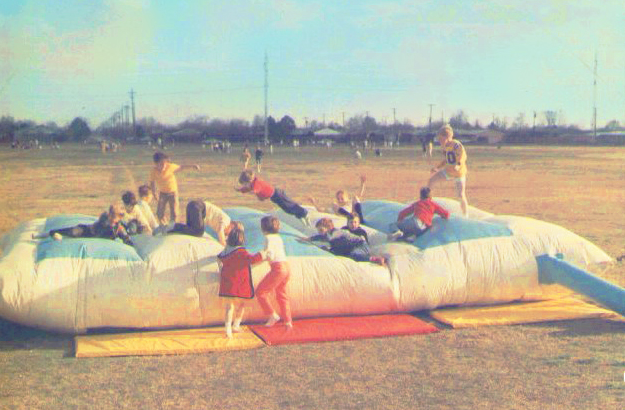The History of Bounce Houses
The history of bounce houses, those ubiquitous and joyful structures at children's parties and events, traces its roots back to the late 1950s and has evolved significantly over the years.
The original concept of the bounce house is credited to John Scurlock, an engineer from Louisiana. In 1959, while experimenting with inflatable covers for tennis courts, Scurlock observed his employees enjoying jumping on the inflatable structures. This observation led to the birth of the bounce house as a play structure. Scurlock's company, Space Walk, began the commercial journey of the bounce house in the early 1960s, with the first commercially sold bounce house named the “Moonwalk,” introduced in 1968 by Robert A. Simon.
Initially, bounce houses were primarily used for industrial purposes. Scurlock's innovations included the safety air cushion, now commonly used by emergency services for rescuing people from heights. The early bounce houses faced challenges, such as the lack of enclosure, which posed safety hazards, and the greenhouse effect created by the enclosed structures, making them unbearably hot in summer. These issues were addressed in the 1970s with the introduction of netted walls, allowing for airflow and cooler interiors.
The evolution of bounce houses has been remarkable, featuring diverse styles, themes, and sizes. From their humble beginnings as simple air-filled structures, they have transformed into a vast array of designs, boasting vibrant colors, imaginative themes, and engaging interactive elements. Innovations in design have included fireproof fabrics, stronger stitching, and the addition of features like slides, tunnels, guard rails, padded floors, splash pools, obstacle courses, and climbing walls. These enhancements not only increased the fun factor but also significantly improved safety standards.
The distinction between commercial and residential inflatables is notable. Commercial-grade inflatables, designed for frequent use at large-scale events or amusement parks, are made with higher-quality materials and construction methods, whereas residential bounce houses are smaller and suited for backyard parties.
Modern-day bounce houses are not just for children; they have found their way into adult entertainment, fitness classes, and various corporate and community events, thanks to their affordability, versatility, and convenience. The industry has seen a rise in themed designs, from popular movie characters to sports themes, making them appealing for a wide range of events and interests.
Safety remains a crucial aspect of bounce house enjoyment. Over the years, safety measures like proper supervision, regular equipment maintenance, adherence to weight limits, secure anchor systems, and compliance with safety guidelines have become standard. Advancements in materials technology have further enhanced safety features, such as the use of flame-resistant materials and reinforced stitching.
From a simple play structure invented in the late 1950s to a diverse and safe entertainment option today, bounce houses have become a staple of joy and laughter at children's parties and events worldwide, offering not just fun but also encouraging physical activity among its users.
The original concept of the bounce house is credited to John Scurlock, an engineer from Louisiana. In 1959, while experimenting with inflatable covers for tennis courts, Scurlock observed his employees enjoying jumping on the inflatable structures. This observation led to the birth of the bounce house as a play structure. Scurlock's company, Space Walk, began the commercial journey of the bounce house in the early 1960s, with the first commercially sold bounce house named the “Moonwalk,” introduced in 1968 by Robert A. Simon.
Initially, bounce houses were primarily used for industrial purposes. Scurlock's innovations included the safety air cushion, now commonly used by emergency services for rescuing people from heights. The early bounce houses faced challenges, such as the lack of enclosure, which posed safety hazards, and the greenhouse effect created by the enclosed structures, making them unbearably hot in summer. These issues were addressed in the 1970s with the introduction of netted walls, allowing for airflow and cooler interiors.
The evolution of bounce houses has been remarkable, featuring diverse styles, themes, and sizes. From their humble beginnings as simple air-filled structures, they have transformed into a vast array of designs, boasting vibrant colors, imaginative themes, and engaging interactive elements. Innovations in design have included fireproof fabrics, stronger stitching, and the addition of features like slides, tunnels, guard rails, padded floors, splash pools, obstacle courses, and climbing walls. These enhancements not only increased the fun factor but also significantly improved safety standards.
The distinction between commercial and residential inflatables is notable. Commercial-grade inflatables, designed for frequent use at large-scale events or amusement parks, are made with higher-quality materials and construction methods, whereas residential bounce houses are smaller and suited for backyard parties.
Modern-day bounce houses are not just for children; they have found their way into adult entertainment, fitness classes, and various corporate and community events, thanks to their affordability, versatility, and convenience. The industry has seen a rise in themed designs, from popular movie characters to sports themes, making them appealing for a wide range of events and interests.
Safety remains a crucial aspect of bounce house enjoyment. Over the years, safety measures like proper supervision, regular equipment maintenance, adherence to weight limits, secure anchor systems, and compliance with safety guidelines have become standard. Advancements in materials technology have further enhanced safety features, such as the use of flame-resistant materials and reinforced stitching.
From a simple play structure invented in the late 1950s to a diverse and safe entertainment option today, bounce houses have become a staple of joy and laughter at children's parties and events worldwide, offering not just fun but also encouraging physical activity among its users.




